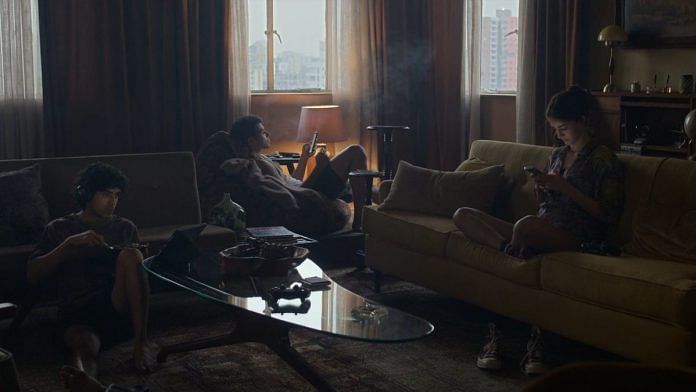In Kho Gaye Hum Kahan, debutant director Arjun Varain Singh and writers Zoya Akhtar and Reema Kagti articulate the internet-induced mess. Social media is both a jailer and liberator, the characters desperately lonely even as they seek instant gratification. Set in Mumbai, their loneliness is compressed into urban spaces: bars that are chicly bare, a rooftop where joints are smoked with casual abandon, and airy apartments that are a far-cry from the city’s usually stuffy homes.
While technology’s influence is ubiquitous and its tangible effects visible across the socio-political spectrum –– Kho Gaye Hum Kahan restricts them to a stylised urban demographic. Two out of three protagonists live lives completely insulated from the outside world. Presumably, the aim is to capture the universality of love in the age of social media, in a manner that is complex enough for the film to be taken seriously by a larger audience.
But when characters from a minuscule section of society are meant to represent something universal, dissonance is assured. Both Akhtar and Kagti were seemingly aware of this, evident from the way Siddhant Chaturvedi’s character Immad Ali is depicted—terms are thrown around and ideas are introduced without giving a second thought to substantiate them. He’s the cookie-cutter version of an “emotionally stunted” man with “trauma”. His issues are complicated, but their treatment is generic. He has a therapist, but their discussions consist mostly of platitudes. He suffers from trauma, and likes a woman with similar experiences. Convenient storytelling.
Also read: Shell to Reel to shell. That’s how shy, introverted GenZ are coping with the pressure to post
A sanitised struggle
This sanitised aesthetic has largely worked for Akhtar-Kagti productions. It’s an exciting contrast when pitted against the angst boiling inside. Moreover, the easy luxury and its uniquely urban-Indian assemblage is fun to watch. Gehraiyaan, with its bizarre plot points and occasional plot holes, worked for the same reason. The popular understanding of the millennial-GenZ demographic—the thrust on heedless intelligence, performative politics and the overarching focus on love and relationships—makes for an entertaining watch, largely because it’s still a relatively unexplored arena in India. Both academically and cinematically.
There’s a lot of new-ness in Kho Gaye Hum Kahan. One of its protagonists, an interesting character in and of himself due to his class insecurity, enters into a relationship with a social media influencer. Her every interaction is transactional, with her internet persona inextricable from her ‘real-life’ self. There’s no ‘authenticity’ and everyone and everything is a means to an end. It’s not an inaccurate representation. The influencer economy is booming, and social media performance is more valuable than ever. She’s also the only character who isn’t taken seriously, which is a definite plus. Ananya Panday embodies the messy, desperate girlfriend trope. These are also accurate portrayals, but the heaviness with which they’re depicted sometimes feels disingenuous.
The film struggles with its desire to be an all-encompassing take on life and love. It inserts the ‘class’ angle but can’t bring itself to commit fully to the cause—the only character who confronts how class shapes social structures lacks the required self-awareness.
Also read: TikTokers dubbed ‘Shudras of internet’: Indians didn’t spare even social media from casteism
Digital mediation
Instagram is the film’s most consistent feature, as are the ways in which characters use it to further their agendas. Imaad is what could be called a Tinder-addict, and manic pixie dream girl-esque Simran (Kalki Koechlin), in true ‘affected artist’ style—is working on a project called ‘Humans of Tinder’. Digital worlds are given the same import as the non-digital, as they’re shaping the characters—confused, in their mid-20s, and in a constant state of flux that is magnified by social media and dating apps.
In an essay titled ‘The I in the Internet’, Jia Tolentino writes: “The presentation of self in everyday internet still corresponds to [sociologist Erving] Goffman’s playacting metaphor: there are stages, there is an audience. But the internet adds a host of other, nightmarish metaphorical structures: the mirror, the echo, the panopticon.”
The Internet is an endless performance, but Tolentino also refers to the fact that there is no respite. Making yourself available to strangers and friends on the internet is an ongoing loop, and it’s difficult to get out of it. Mostly because of all that it gives you –– instant gratification, a sense of self-identity and worth, and all-important social currency.
It’s also the fact that real-world relationships are digitally mediated. This is where the film works most, as it captures how our phones are extensions of ourselves, where intimacy is built, and often destroyed.
Views are personal.
(Edited by Prashant)



